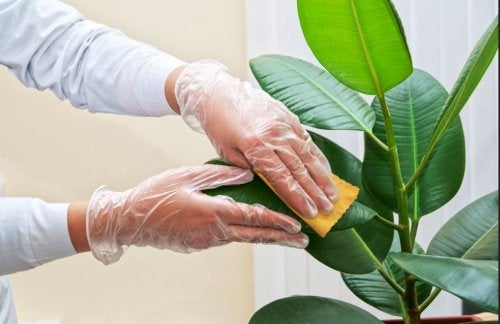Cleaning the leaves of the plants is also important. This is because keeping them in good condition and cared for favors their breathing. How to do it? In this space we share several methods. Cleaning the home is a task that requires skill; the elements that complete it need their own care, also the plants and their leaves.

Cleaning the leaves of the plants is also important. This is because keeping them in good condition and cared for favors their breathing. Dust or the same pollution can accumulate on them and thus considerably reduce the amount of sunlight they receive.
This can cause the plant to develop less chlorophyll and thus eventually become ill. In this way, the plant will turn yellow and stop growing. In fact, in time you could even die.
Therefore, cleaning those plants that do not receive rainwater is very important to maintain their health. It is best to repeat this procedure at least twice a month.
Methods for cleaning plant leaves.
According to information published in an online platform, the ways to clean plant leaves can vary according to the type of leaves and the nature of the soil. In general it is a simple task, but not always fast. Let’s see some options:
1. Water as the first resource.
Water is a good resource to clean the leaves of plants. In fact, it is the most common.
A good tip is to move the plant to the shower and turn on the tap. Make sure the water is warm and doesn’t come out with too much force. Thus, you will receive soft drops instead of a more intense and direct jet that can damage the leaves. Using a hose or sprayer can also go a long way.
If the dirt on the plant is very abundant, you can mix a liter of water with a few drops of shower gel. Spray it with this preparation and then rinse with clean water. Those who recommend this method point out that it is better to cover the substrate or lay down the plant so that this mixture only remains on the flowers.
2. Natural brightener.
It is an effective technique, except for those plants with curly leaves or with small hairs. It is not advisable to use natural brighteners on them. In the rest of the plants it can give very good results.
When using it, wipe the sheets with a sponge with soapy water to make them shine. Another option is to make it with olive oil. In both ways, you can give your plants more shine.
3. Cleaning plants with a toothbrush.
In the second point we emphasize maintaining certain caution with velvety plants or with small hairs. They are more fragile and can be more easily damaged. To clean them, you can use an old toothbrush.
First, place the blade in your hand and gently brush over it. Start from the base and work your way carefully to the tip of the blade. Remember to rinse the brush from time to time and let it dry before using it to clean the plant leaves.
Some other objects that can be used for this technique are soft brushes or pipe cleaners, or for example a brush. What’s more, even a leaf of the same plant can be useful to remove the dust from the rest of them.
Other tips.
It is important to clean the leaves of the plants, but you also have to offer them other care. For example, it is essential to eliminate those parts of the plant that are not healthy.
If the plant has withered flowers or dry, yellowish or weak leaves, it is best to remove them. In this way, it will be able to dedicate all its resources to the conservation and proliferation of its healthy parts.
In the same way, it is advisable to take into account what are the characteristics of each plant to maintain its care correctly. For example, there are some that are not favored when their leaves get wet; some examples are cacti and succulents. For them, it is better to opt for dry cleaning.
Cleaning the leaves of the plants is something that takes just a few minutes. However, it can have very positive effects for them. If you use them in interior decoration, a healthy and shiny appearance will totally change the vitality of the environments.


